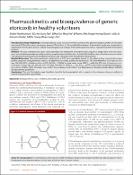Options
Pharmacokinetics And Bioequivalence Of Generic Etoricoxib In Healthy Volunteers
Journal
Generics and Biosimilars Initiative Journal (GaBI Journal)
Date Issued
2021
Author(s)
Nishalini Harikrishnan
Ka-Liong Tan
Kar Ming Yee
Alia Shaari Ahmad Shukri
Nalla Ramana Reddy
Chuei Wuei Leong
DOI
10.5639/gabij.2021.1003.013
Abstract
Introduction/Study Objectives: A bioequivalence study was performed to compare the pharmacological profile of innovator etoricoxib (ETO) with a newly developed generic ETO, both in a 120 mg tablet formulation. A dissolution study was conducted to optimize the formulation process before evaluating physical changes in the active pharmaceutical ingredient and the formulated product.
Methods: This was a randomized, open-label, balanced, two-treatment, two-period, two-sequence, single-dose, two-way crossover, truncated bioequivalence study involving a washout period of ten days. A total of 26 healthy male volunteers were recruited. The pharmacokinetic profile of the test formulation was compared with the reference formulation.
Results/Discussion: The pharmacokinetic parameters of ETO were calculated based on the plasma drug concentration-time profile using non-compartmental analysis to determine its safety profile and tolerability. The Test/Reference (T/R) ratio of ETO was 104.36% (90% confidence interval (CI): 98.30%–110.80%) for area under curve (AUC)0-72 while the T/R ratio of maximum concentration (Cmax) was 101.39% (92.15%–111.56%). The 90% CI of the Cmax and AUC0-72 of ETO were within acceptable bioequivalence limits of 80%–125%. All values were within the predetermined limits of the Association of Southeast Asian Nation (ASEAN) bioequivalence guidelines.
Conclusion: The test formulation was found to be bioequivalent with respect to the reference drug, according to ASEAN bioequivalence guidelines.
Methods: This was a randomized, open-label, balanced, two-treatment, two-period, two-sequence, single-dose, two-way crossover, truncated bioequivalence study involving a washout period of ten days. A total of 26 healthy male volunteers were recruited. The pharmacokinetic profile of the test formulation was compared with the reference formulation.
Results/Discussion: The pharmacokinetic parameters of ETO were calculated based on the plasma drug concentration-time profile using non-compartmental analysis to determine its safety profile and tolerability. The Test/Reference (T/R) ratio of ETO was 104.36% (90% confidence interval (CI): 98.30%–110.80%) for area under curve (AUC)0-72 while the T/R ratio of maximum concentration (Cmax) was 101.39% (92.15%–111.56%). The 90% CI of the Cmax and AUC0-72 of ETO were within acceptable bioequivalence limits of 80%–125%. All values were within the predetermined limits of the Association of Southeast Asian Nation (ASEAN) bioequivalence guidelines.
Conclusion: The test formulation was found to be bioequivalent with respect to the reference drug, according to ASEAN bioequivalence guidelines.
Subjects
File(s)
Loading...
Name
Pharmacokinetics and bioequivalence of generic etoricoxib in healthy volunteers.pdf
Size
269.45 KB
Format
Adobe PDF
Checksum
(MD5):3dc685a15dd45f5a9c1fdb8f0f42e241